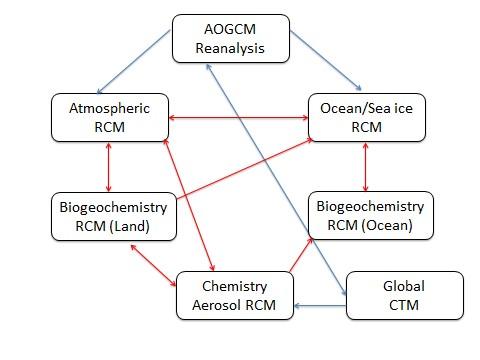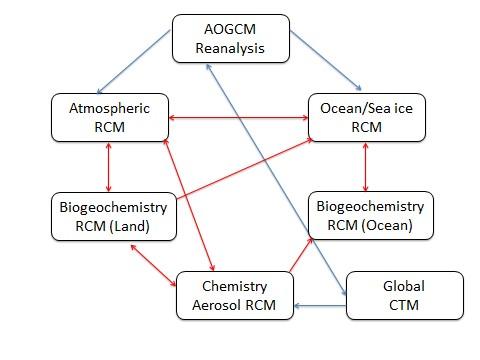
Credit: Filippo Giorgi
The regional climate modeling community is actively engaged in the development of regional earth system models (RESMs), applicable in different regional contexts. In a paper published in Atmospheric and Oceanic Science Letters, Prof. Filippo Giorgi from the Abdus Salam International Centre for Theoretical Physics in Italy, and Xuejie Gao from the Institute of Atmospheric Physics, Chinese Academy of Sciences in Beijing, review recent progress in, and future directions for, the field of regional earth system modeling.
But what is an RESM? Professor Gao explains: "Previously, RCMs [regional climate models] were atmosphere-only. However, the climate system consists of more than just the atmosphere. Hence, RESMs have emerged, which also take into account other key components of the earth system–for instance, the ocean, land, and sea ice".
The basic structure of a coupled RESM is illustrated in the Figure. Currently, several coupled RESMs exist, varying in their sets of components, and have been applied to a wide range of different regions, including East Asia and China. Some models include multiple earth system components, such as the atmosphere, ocean, sea ice, hydrology, land and/or marine biogeochemistry, while others adopt a simpler set of constituent models.
"Clearly, the development of RESMs is still in its infancy, but will undoubtedly receive increasing attention in the coming years," adds Prof. Gao. Indeed, the paper highlights that more work and intercomparison studies are needed to assess the transferability of these coupled models. The inclusion of an interactive biosphere has been limited so far, but the interest in this aspect is growing and is especially important within the context of future climate change, which may lead to pronounced changes in natural ecosystems.
Aside from fully coupling the atmosphere, ocean, cryosphere, biosphere, and chemosphere, the next challenge in RESM modeling is the inclusion of the human factor, as concluded by the authors. Human activities are currently considered in most model experiments as external players in the climate system, either as forcings or as receptors (e.g., impacts). However, there is a two-way interaction between human societies and the natural environment. In an era where humans are now a key component of the climate system, these processes will have to be included in the next generation of earth system models.
###
Media Contact
Zheng Lin
[email protected]
86-108-299-5053
@aasjournal
http://english.iap.cas.cn/
Original Source
http://english.iap.cas.cn/RE/201806/t20180629_194599.html http://dx.doi.org/10.1080/16742834.2018.1452520





